Need a bike pannier or cycle rack? Our expert has found the best on the market for 2021
This article contains affiliate links. We may earn a small commission on items purchased through this article, but that does not affect our editorial judgement.
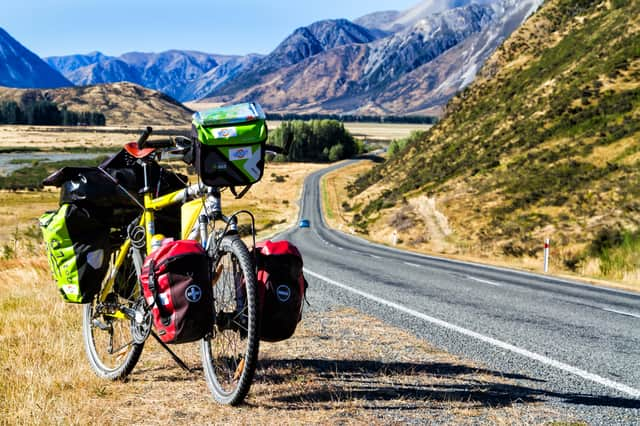

What is a pannier?
A pannier is a bag designed to attach to a bicycle, providing an easy and comfortable way to carry things while you ride.
Pannier bags are typically attached to a component called a pannier rack, which is itself attached to the frame of the bike. Most pannier racks are designed to attach to a specific part of the frame, usually at the rear, but sometimes at the front, of the bicycle.
We get the word ‘pannier’ from the Old Frenchpanier, which originally referred to bread baskets carried in pairs by beasts of burden. Bicycle panniers are used nowadays by all sorts of cyclists, from commuters carrying their work supplies, to adventurers taking provisions on a bicycle tour.
How to choose a pannier rack and pannier bag?
We recommend you start by choosing a pannier rack, since only certain racks will fit your bicycle.
First off, you will need to identify which parts of your bicycle’s frame could accommodate a pannier rack. Some bikes have eyelets at the dropouts, which are used to mount many ‘standard’ pannier racks. For bicycles which lack this feature, it’s sometimes necessary to mount a pannier rack to the seat post, or at the front of the bike.
If you’re new to panniers and pannier racks, try to get some advice from someone who has relevant experience before you make any decisions. Bicycles vary greatly, and sometimes a fine detail, such as the presence of disc brakes, could make a certain bike incompatible with a certain pannier.
Once you’ve chosen a pannier rack, you can move on to selecting the ideal pannier bag(/s) for your purposes. You should consider factors including how much load you will need to carry, and which types of pannier are compatible with your pannier rack.
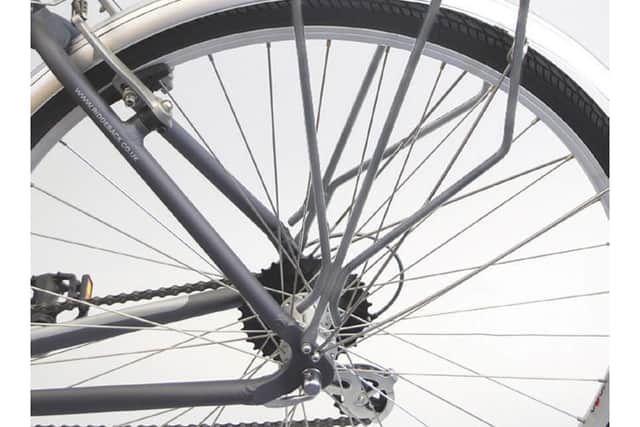

Type: rear
Max load: 25kg
Attaches at: seat stay and dropouts (eyelets)
Made in a strong, lightweight alloy, the M Part ATP3 Trail is a brilliantly efficient solution for carrying your pannier bags.
The rack attaches at both the dropouts and the seat stay, which means it’s only suitable for bikes which have eyelets on the dropouts.
The adjustable arms used to attach the rack to the seat stay slide out a good distance, providing scope to attach the rack to a variety of bicycle frames.
Shiny and smart-looking, this would be an ideal rear pannier rack for commuting – although mechanically, it’s also suitable for getting muddy on a road cycling tour.
The texture on the top of the rack adds a little extra grip, while the struts on each side do a great job of keeping side-mounted bags clear of the rear wheel.
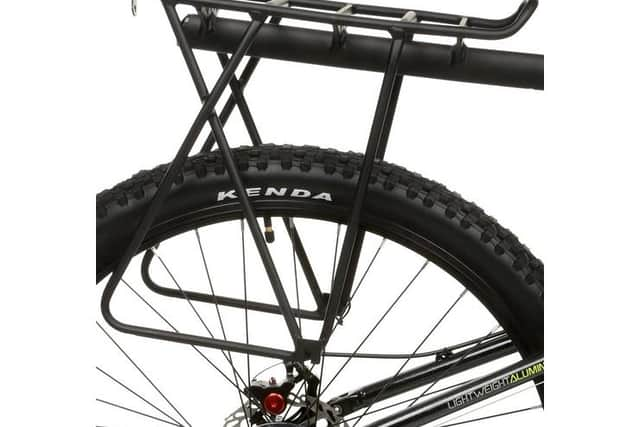

Type: rear
Max load: 25kg
Attaches at: seat stay and dropouts (eyelets)
Here’s a great-value-for-money rear pannier rack from Halfords.
Constructed from lightweight aluminium, the rack is perfect for cyclists who are aiming to carry lots of gear without adding too much weight to their bicycle.
Fitting the rack is nice and easy, with simple hardware to attach the front of the rack to the bicycle’s seatpost, plus an eyelet attachment at the bottom.
This pannier rack’s brushed finish does have a tendency to mark quite easily, but this shouldn’t get in the way of its functionality.
Please note that this pannier rack is not suitable for bikes that have disc brakes or rear suspension.
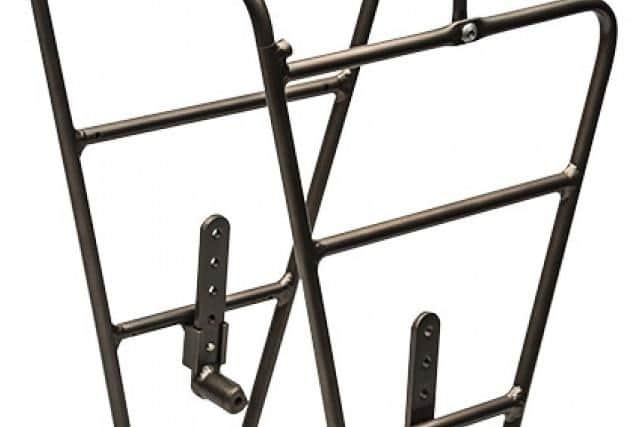

Type: front
Max load: 20.5kg
Attaches at: frame and front dropouts (eyelets)
Built for globe-trotting bicycle touring, the Blackburn Outpost Front Rack is a superb option for cyclists seeking a smart way to load lots of gear onto the front of their bike.
Perhaps the greatest benefit of this rack is its adjustability.
You can load your panniers onto the rack at a choice of different heights, which will help you to get any given pannier bag as low as possible, resulting in a desirably low centre of gravity.
Plus, the top part of the rack is removable, allowing for a more stripped down design when needed.
The only arguable downside to this premium rack is the price. Nonetheless, it’s a superb option for serious touring.
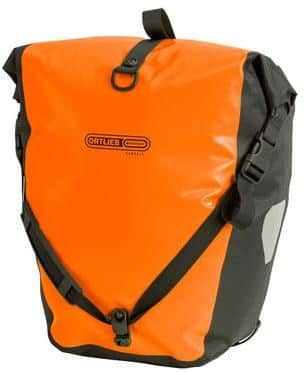

Type: classic (pair)
Max load: 20 L per bag
Attaches at: rack sides
Ortlieb’s classic pannier bags perform excellently, and they look great while they’re at it, with a choice of snazzy colours including orange, red, black and grey.
Rather than breaking the mould, this bag absolutely nails the basics. Its waterproof material is reliable and hard-wearing, and the roll-top fastening is both highly effective and easy to use.
Another significant benefit to this pannier is the sophisticated ‘QL2.1’ system it uses to attach to the pannier rack.
This incorporates secure, adjustable fastenings both at the top and near the bottom of the rear panel.
These bags are sold as a pair, with one for each side of your pannier rack.
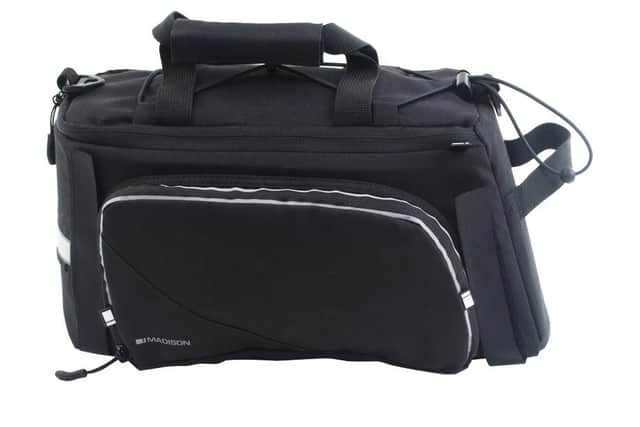

Type: rack-top
Capacity: 14.6 L
Attaches at: rack top and seat post
There’s a lot to love about this clever rack-top pannier bag from Madison.
Though the bag may look neat and small, it makes really efficient use of space, with drop-down side pockets that can increase the overall capacity to 14.6 L.
Another useful feature is the pair of zippered mesh compartments on the inside of the bag’s upper – ideal for storing essentials such as travel documents or spare bike light batteries.
The exterior of the RT20 is just as feature-packed as the interior, with Scotchlite reflective strips to enhance visibility, a loop for your rear bike light, and convenient carry handles for off-bike use.
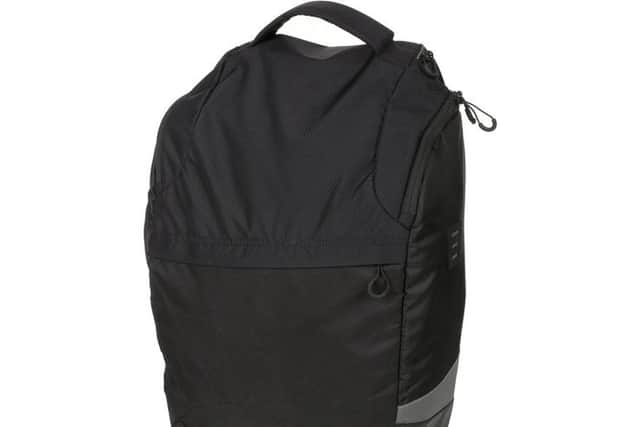

Type: classic (sold individually)
Capacity: 15 L per bag
Attaches at: rack sides
This pannier bag covers the basics very well and at very modest expense.
Mounting it to a pannier rack is simple: just use the sturdy clips on the rear panel of the bag, and possibly also the Velcro strap on the same side, depending on the style of pannier rack used.
We were impressed with this bag’s roominess and resilience to the elements.
The three compartments provide ample space for all manner of luggage, from camping gear to laptops and lunchboxes.
And the water resistant panels on the bottom and back did a great job of keeping our belongings dry during a test ride.
We recommend using two of these bags as a pair, with one on each side of your pannier rack.